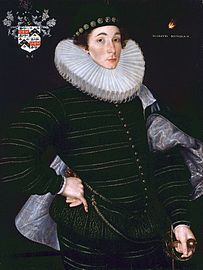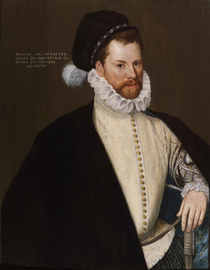Cornelis Ketel
Cornelis Ketel | |
|---|---|
 Cornelis Ketel by Hendrik Bary | |
| Born | 18 March 1548 |
| Died | 8 August 1616 (aged 68) |
| Known for | Painting |
| Movement | Mannerism |
| Children | 1 |
Cornelis or Cornelius Ketel (18 March 1548 – 8 August 1616
According to Ketel's biography, written by his contemporary
Life

Ketel was born in
He returned to Gouda, but the economy there was severely hit by the occupation of the city in 1572 by the

Finding no market in England for his preferred allegorical subjects, Ketel returned to the Low Countries as his son Rafaël was born in Amsterdam in 1581. Ketel introduced the full-length group portrait format to the Dutch burghers with great success,
After the death of wife in 1602, he remarried in 1607 to Aeltge Jans, but not in a
Works
London years

Ketel quickly established himself as a successful painter of portraits in London. Karel van Mander records that Ketel was patronized by the prosperous German
Apparently, all of Ketel's allegorical paintings have been lost, however, a formerly lost masterpiece was discovered and exhibited at the Tate Museum, London, in 1995, in a major exhibition entitled Dynasties. Painting in Tudor and Jacobean England 1530-1630. Attribution as to title of this work, this may be the lost "Triumph of Wisdom and Prudence over Force" 1580, painted in England. (Miedema-Schulting 1988)[
Records indicate that Ketel charged £1 for a head-and-shoulders portrait and £5 for a full-length.[20] Nicholas Hilliard, then in his prime as a painter of portrait miniatures, typically charged £3 for a miniature.
Later works

Some of Ketel's history paintings are documented in various ways, including a
Ketel's 1588 The Company of Captain Rosecrans, the earliest Dutch group portrait where the figures are shown standing and full length, "greatly influenced later artists of militia pieces, such as Rembrandt in his
Together with
Gallery
-
Sir Martin Frobisher, 1577
-
Thomas Pead, 1578. The skull is inscribed "Respice finem".
-
Richard Goodricke of Ribston, 1578
-
John Smythe, 1579
-
Thomas Cecil, First Earl of Exeter. 1575
Notes
- ^ "Cornelis Ketel". Netherlands Institute for Art History. Retrieved 2018-08-07.
- ^ a b c d Rudolf Ekkart, Cornelis Ketel, Grove Art Online, accessed January 31st, 2008
- ^ Dutch online text, from the DBNL, K. van Mander, Het Schilder-boeck, Haarlem, 1604 (reprinted Utrecht 1969, translated as The Lives of the Netherlandish and German PaintersH. Miedema, ed. 1994-99).
- ^ Lionel Cust, "Notes on Pictures in the Royal Collections-XXIV. On Some Portraits by Cornelis Ketel" The Burlington Magazine for Connoisseurs 22 No. 116 (November 1912:88-89, 92-940 p. 93.
- ^ "Cornelis Ketel." The Concise Grove Dictionary of Art. Oxford University Press, Inc., 2002. Answers.com 28 Jan. 2008. [1]
- ^ James, Painters and Their Works, p. 38
- ^ Hearn, p. 103
- Ditchleyand with the Earl of Winchilsea.
- ^ Cust 1912:93, following van Mander.
- ^ Hearn, p. 105
- ^ R.H. Wilenski, Dutch Painting, "Prologue" pp. 27-43, 1945, Faber, London
- ^ "Inventarissen".
- ^ Hearn, p. 105
- ^ Waterhouse p. 39
- ^ Hearn, p. 109, and Strong, Gloriana, p. 101. The Sieve Portrait of Elizabeth in Siena, which Strong suggested might be by Ketel, is now known to be the work of Quentin Metsys the Younger; see Hearn, p. 85.
- ^ Hearn, p. 108-109
- ^ Cust eo. loc..
- ^ Cust, eo. loc..
- ^ Hearn, p. 108-110
- ^ Strong, English Icon, p. 49
- ISBN 0-300-07451-4; a Heraclitus is in the collection of James O. Belden, Washington, DC (Galley 2004:88, fig.1).
- ISBN 0-300-10237-2
- ^ Rijksmuseum web site Archived 2005-02-22 at the Wayback Machine, retrieved 26 January 2008
- Nicolaes Eliaszoon Pickenoy, who was probably trained by Cornelis van der Voort, who was probably trained by Ketel
- ^ Hals "Meagre Company"
- ISBN 0-500-20167-6
- ISBN 978-1-85709-362-9
- ^ J. Richard Judson, "A New Insight into Cornelis Ketel's Method of Portraiture" Master Drawings 1.4 (Winter 1963:38-41, 88-89)
- ^ Judson 1963; Slive:7; Nicolas Galley, "Cornelis Ketel: A Painter without a Brush" Artibus et Historiae 25.49 (2004:87-100).
- ^ Grove op cit
References
- Cust, Lionel: "Notes on Pictures in the Royal Collections-XXIV. On Some Portraits by Cornelis Ketel" The Burlington Magazine for Connoisseurs 22 No. 116 (November 1912)
- Ekkart, Rudi, and Quentin Buvelot, eds. Dutch Portraits, The Age of Rembrandt and Frans Hals, Zwolle: Mauritshuis/National Gallery/Waanders Publishers 2007, ISBN 978-1-85709-362-9
- Franits, Wayne. Dutch Seventeenth-Century Genre Painting, Princeton: Yale University Press, 2004, ISBN 0-300-10237-2
- Hearn, Karen, ed. Dynasties: Painting in Tudor and Jacobean England 1530-1630. New York: Rizzoli, 1995. ISBN 0-8478-1940-X
- James, Ralph N. Painters and Their Works: A Dictionary of Great Artists who are Not Now Alive, London: L. Upcott Gill, 1897, digitized at Google Books, retrieved 3 February 2008
- Judson, J. Richard, "A New Insight into Cornelis Ketel's Method of Portraiture" Master Drawings 1.4 (Winter 1963)
- Slive, Seymour, Dutch Painting, 1600-1800, Princeton: Yale University Press, 1995, ISBN 0-300-07451-4
- Strong, Roy,The English Icon: Elizabethan and Jacobean Portraiture, 1969, Routledge & Kegan Paul, London (Strong 1969)
- Strong, Roy: Gloriana: The Portraits of Queen Elizabeth I, New York: Thames and Hudson, 1987, ISBN 0-500-25098-7(Strong 1987)
- Waterhouse, Ellis; Painting in Britain, 1530-1790, 4th Edn, 1978, Penguin Books (now Yale History of Art series)





